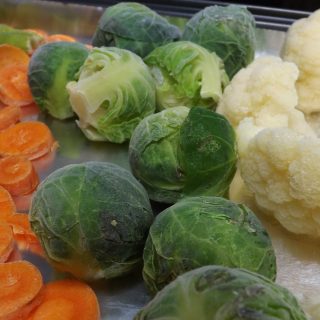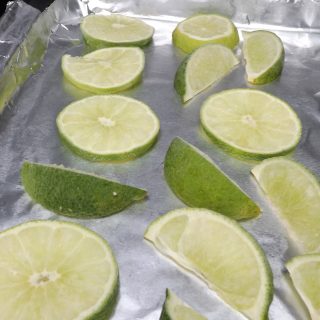Every year around St Patrick's Day and New Years millions of people across the globe make a dash for corned beef, black eyed peas, and, of course, cabbage. Usually, the corned beef and peas don't survive a single meal, but the cabbage generally has leftovers; both cooked and unused, raw pieces. If you'd like to save them, you're in luck, because you can freeze cabbage.
If you're all in on freezing cabbage like we are, keep on reading to learn the variety of ways it can be done!
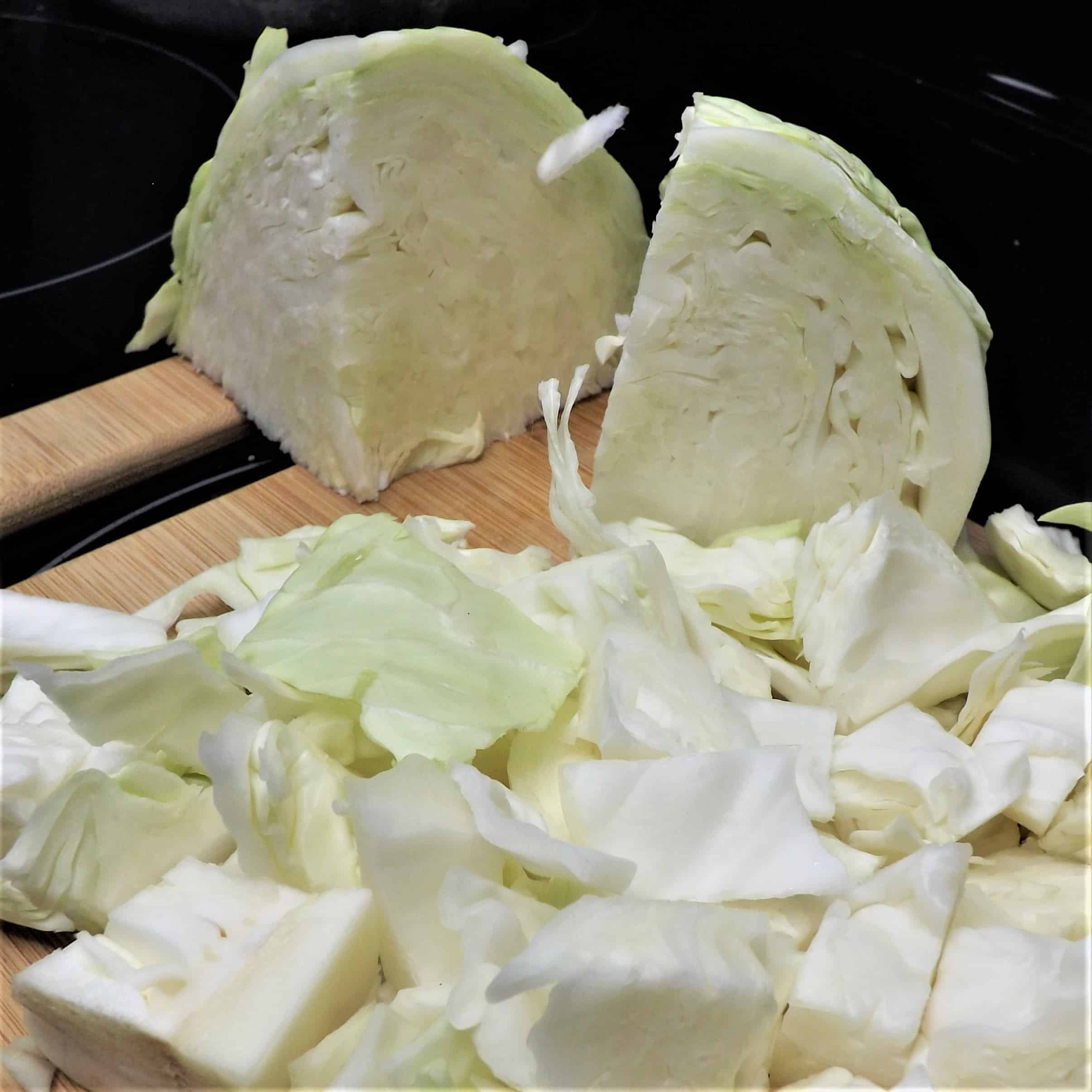
[ez-toc]
Can you freeze cabbage?
Yes, you can freeze cabbage in a variety of different ways. It can be frozen raw or cooked and as a whole head (not recommended), wedges (a little more okay), chopped (now you're getting it), and shredded (there you go!).
Depending on the size and how you want to freeze it can be done with or without blanching. Frozen cabbage can keep for up to 18 months but is best in the first 3 to 4 months of freezing. Best of all, it doesn't need to be thawed before you throw it in a soup or stew, which cuts down on potential soggy leaves!
Cabbage is wonderful in that there are so many different varieties like red cabbage, purple cabbage, green cabbage, and even Bok Choy. Not only can any of these (plus more) work amazingly well in recipes, they can also all be frozen using any of the techniques we discuss today.
Though cabbage does OK frozen, other leafy vegetables (like when you try to freeze lettuce) don't tend to fair quite as well.
Freezing Stats
| Blanched | no (full head and wedges) 1 to 2 minutes (shredded) 2 to 3 minutes (chopped) 3+ minutes (wedges depending on size) |
| Prep Style | whole, wedge, chopped, shredded |
| Time To Freeze | 12 to 24 hours |
| Time to Thaw | a few hours in the refrigerator no need if adding to recipe (soups, stews, etc) |
| Uses | best in soups and stews |
| Freezer Life | 12-18 months best quality in the first 3 to 4 months |
Why should you freeze it?
Cabbage still remains favorable for a while after it has been frozen but it's best within the first 3 or 4 months of freezing. It will still remain safe to eat all the way up to 18 months but quality will severely degrade after that initial 3 to 4 month period. Generally, freezer burn is the culprit
Frozen Vs Non-frozen
| Freezer Life | Shelf Life/Fridge Life |
| 12-18 months best quality in the first 3 to 4 months | 2 to 3 weeks (wrapped and uncut) 2 to 3 days (unwrapped and cut) 3 to 5 days (cooked in fridge) 1 to 2 hours (cooked & left out) |
Supplies
- cabbage (any kind)
- colander
- mandolin slicer with protective gloves (for shredding)
- knife and cutting board (for shredding if no mandolin slicer)
- large stock pot
- large mixing bowl
- kitchen timer
- Measuring cup
- cookie sheet (for flash freezing)
- Freezer bags
- Sharpie or marker
- Freezer
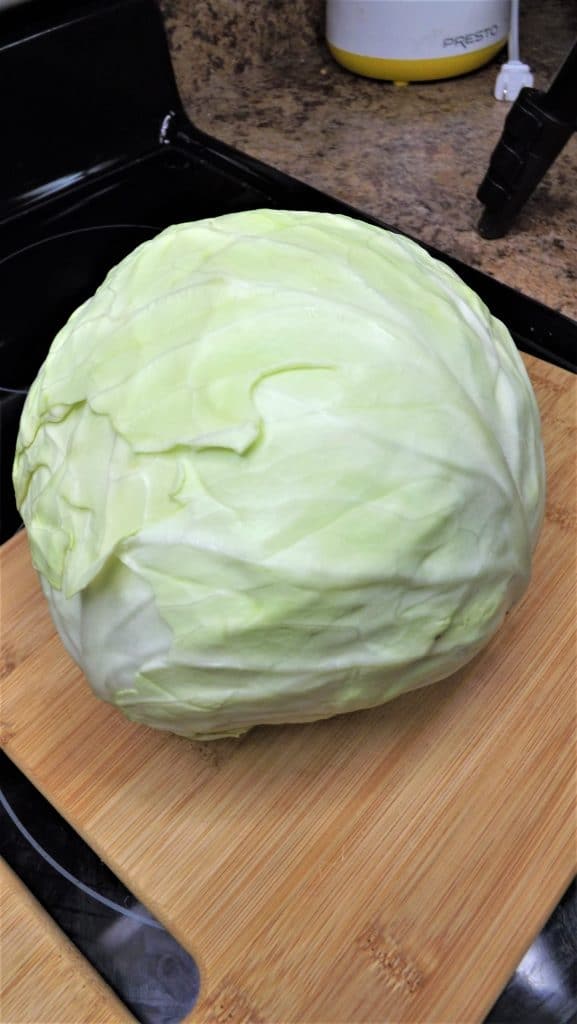
How To Freeze Cabbage
We have a couple of ways to freeze cabbage; whole head, chopped/wedges, and shredded. We will over each method below and which method will give you the best results.
Need to get all your food preserved easily? Check out the Ultimate Guide To Freezing Food so that you can fill your freezer without in minimal time.
Step One
This step is mostly the same for any method you choose. You will want to gather all of your supplies together so they are easily accessible.
Whole head or wedges
To preface, we DO NOT recommend freezing an entire head of cabbage. It takes longer to freeze (which can cause freezer burn), longer to thaw (which can make your cabbage soggy and withered), is bulky and takes up more space than other methods.
Buuuuuut....if you insist...
Remove the outer leaves and soak the entire head of cabbage in a salt water brine. Fill a large mixing bowl or basin with warm water, add in a handful of salt, and let the cabbage soak for about 15 minutes or so, occasionally shaking the head to dislodge any insects that may be stuck.
Wedges, chopped, and shredded
Cut your cabbage in whichever method you choose. Wedges are not quite as bad as freezing a whole head but you still run into some of the same problems. Both chopped and shredded are much easier and yield better results.
The easiest way to cut wedges or chop cabbage is with an old fashioned knife and cutting board. You can also use a knife for shredded cabbage but we prefer a mandolin slicer.
Place your cabbage in a colander in your sink. Run cool water and rinse off any dirt and grime you may see. Make sure each piece gets good coverage and you should be fine.
Step Two
Without Blanching
Again, we do not think skipping blanching is a good idea unless yo plan to eat the cabbage very, very soon (in which case, just put it in the fridge where it will stay fresh for up to 3 weeks if it stays wrapped).
You can freeze any of these types of cabbage without blanching by following the cleaning and cutting methods in step one, drying everything completely, bagging them, and putting them in the fridge.
Easy peasy, but won't give you great results.
With Blanching
The act of blanching your food is like a form of partial cooking. Many veggies and fruits have an enzyme that will make them continue to age even after being frozen. That means freezing will only slow the process down and your cabbage will still rot. Hence why we don't think skipping this is a good idea.
Blanching a full head is probably technically possible, but we wouldn't try it. However, wedges, chopped cabbage, and shredded cabbage are all good candidates and will give you good results.
How to blanch
To blanch you will need a second colander (or at least wash the first one before reusing it), large mixing bowl, and a stock pot. Fill the pot with water and set it on your stove top to boil (remember, don't watch or it never will 😂).
While you are watching for it to boil, fill your mixing bowl with cold ice water and put your cabbage in the colander. Once your water is at a good rolling boil, lower the colander down into the water. Set a kitchen timer for:
- 1 to 2 minutes for shredded cabbage
- 2 to 3 minutes for chopped cabbage
- 3+ minutes for wedges
Times may vary depending on the size and amount of cabbage you are blanching. You only want to boil the cabbage long enough to kill the aging enzymes. When your timer goes off take your cabbage and dunk it in the ice bath you have waiting in the mixing bowl.
Now that the aging process has been stopped with blanching we use an ice bath to stop the cooking process.
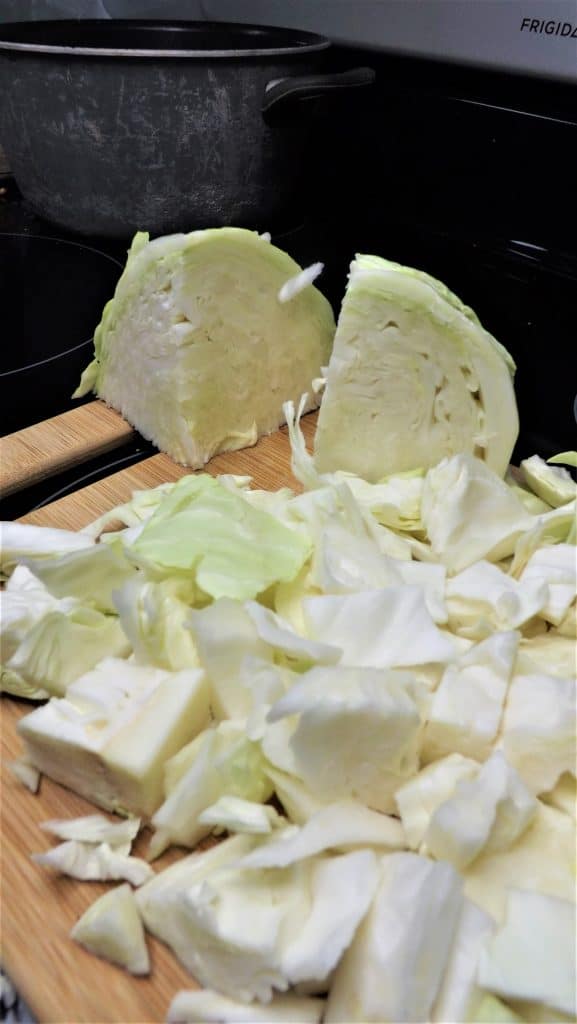
Step Three
You will now take your cabbage and let it dry. We usually will lay it out on or pat it down with paper towels. You want to remove as much excess moisture as possible to prevent freezer burn later on.
While your cabbage is drying pull out your your storage bags and sharpie or marker. Label them with the contents, amount, freeze date, and a best by date. You can also include an expiration date since frozen cabbage is best within the first 3 months and will go bad between 12 and 18 months.
Your cabbage should be dry by now. Take out your cookie sheet and cover it with aluminum foil or parchment paper; we will use this for flash freezing.
What is flash freezing?
Flash freezing, in home food preservation, is basically a pre-freeze before the long term deep freeze. It works best with smaller foods and portions like when you freeze blueberries, freeze blackberries, freeze carrots, freeze watermelon freeze cantaloupe chunks chunks, and freeze raspberries. For example, shredded or chopped cabbage will give great results when flash frozen.
To do this, you will make a single layer of cabbage on the cookie sheet; spread out for shredded and individual leaves for chopped. Then place the cookie sheet in the freezer for a couple of hours. When you come back, the cabbage will have started to freeze enough that you can move on to the long term storage section in step four.
Step Four
After you flash freeze your cabbage, put it all in your labeled storage bags. You should have removed most of the water in step three; which is the first phase of avoiding freezer burn. When you close the bags up, you want to remove as much air as you can.
Air and moisture in the bag will lead to sublimation; the chemical reaction that results in freezer burn (check out that link if you want a more scientific explanation). It's almost impossible to stop freezer burn. However, it is not too difficult to hold off for a while.
You can:
- make sure the freezer stays closed until your cabbage has had time to completely freeze. Frequent opening and closing will cause the temperature to move around a lot which can make the freezing process take longer and also result in condensation.
- use your frozen food earlier than fresh foods. The less time they spend frozen they less likely they are to become experience freezer burn.
- make sure your freezer's internal temperature is down to at least 0° (zero degrees Fahrenheit). This will also shorten the freezing time.
- only use containers just big enough to fit your cabbage in. Smaller containers have less space for air and thus less likely trigger sublimation as early.
Pro tip: The best way to squeeze all of the air out of the bag is to use your sink and take advantage of water pressure. Lower the bag into a sink or bowl full of water while zipping the bag almost shut. Leave a small opening on one end and dip the bag down to that point.
Water pressure will squeeze the bag and push all of the air out the top. Then just seal it and move to step 5.
Step Five
Now it's freezin' time!
Things tend to fit better when you can lay them out flat. Shredded cabbage is the easiest to do this with chopped cabbage not far behind. Wedges are more difficult to lay flat and whole heads are nearly impossible.
Place all of your bags in the freezer. If you have older frozen food already in the freezer, make sure to put the new frozen food behind it. This is called the "first in-first out" (or FIFO) rule. Basically, you want to make sure you use the food in the order it is frozen so nothing gets lost and goes to waste; this is why we like to include the date when labeling storage bags and containers.
How do you defrost it?
Cabbage is great because it is mostly used for soups and stews so you don't need to defrost it; you can add them straight into the recipe. If you are making something like coleslaw or sauerkraut (you can also freeze sauerkraut), you can leave the freezer bag in the fridge over night or even run cold water over it in the sink until it is thawed enough to use.
Frequently Asked Questions
Here are some of the more common questions about freezing cabbage.
Q1. Can you pan fry frozen cabbage?
You can but it will probably not turn out well. Most vegetation will become soggy once it thaws; especially the ones with a lot of water and moisture in them (tomatoes, lettuce, bok choy, etc). So pan frying your cabbage is not really a good idea.
Q2. Can you freeze cooked cabbage and noodles?
Cooked cabbage and noodles is an easy dish to freeze. Since it's already been prepared you do not need to go through all of the steps from above. All you need to do is put it into an airtight bag or container, squeeze out any remaining air, and put it in the freezer (don't forget to label and date it).
It should stay good for a couple of months. To reheat it, just take it out, put it in a microwaveable bowl, cover it, and heat it.
Q3. Can I freeze corned beef and cabbage?
Corned beef and cabbage freezes and reheats pretty well. Just wrap or put them in an airtight, freezer safe bag or container and put them in the freezer. Reheat them in the microwave or in the oven and it will taste almost as good as when you cooked it.
Final word
So, freezing cabbage is really easy. As with any fruits and vegetables, they are never going to have the same taste, texture, and quality as when they are fresh. But, cabbage holds up pretty well when frozen. It works best when used in warm meals like soups or stews, but is definitely something that we would not hesitate to add to our food preservation list.
If you need more help getting your foods frozen, check out the Ultimate Freezing Food Guide for a complete quick start reference so that you can have a well-stocked freezer.

